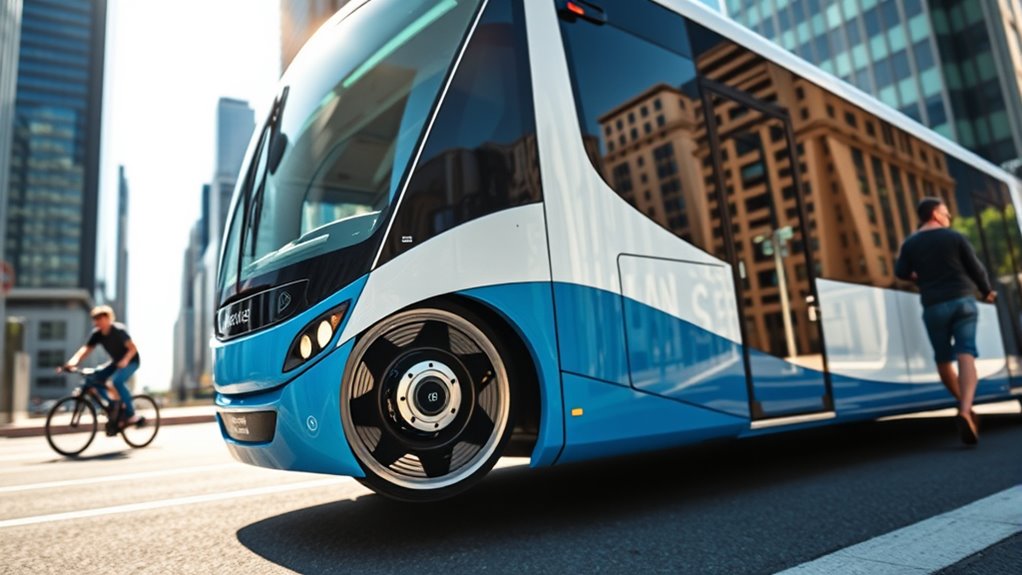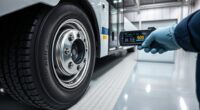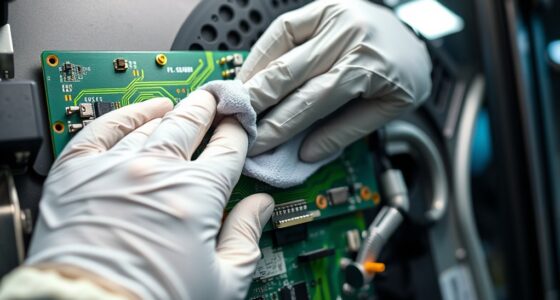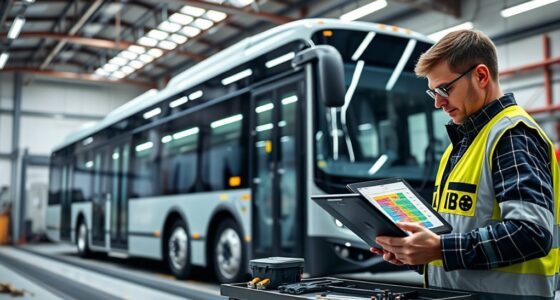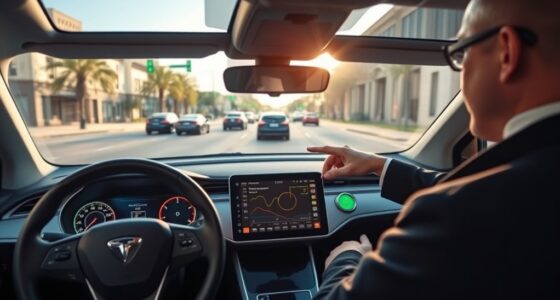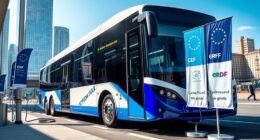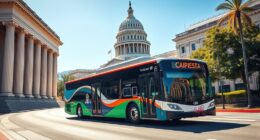Regenerative braking in electric buses recaptures energy during deceleration by turning the electric motor into a generator, converting kinetic energy into electrical power that recharges the batteries. This system works alongside traditional mechanical brakes, reducing wear and boosting efficiency. It helps extend range, lower maintenance costs, and cut emissions. Factors like environmental conditions and system integration can affect performance. If you’re interested, you’ll find more details on how these systems optimize safety and energy use below.
Key Takeaways
- Regenerative braking captures kinetic energy during deceleration and converts it into electrical energy for battery storage.
- Electric motors function as generators during braking, reducing reliance on mechanical brakes and increasing efficiency.
- The system combines regenerative and mechanical brakes to ensure safety and maximize energy recovery.
- Proper energy management and control software optimize braking force distribution based on vehicle conditions.
- Benefits include extended range, reduced brake wear, lower energy consumption, and environmental advantages like zero emissions.
What Is Regenerative Braking and How Does It Work?
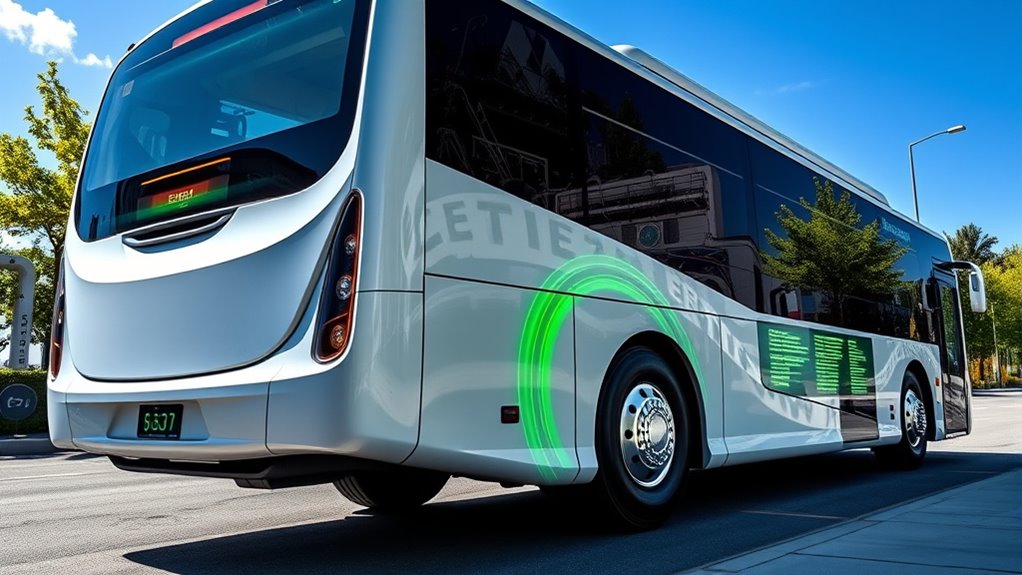
Regenerative braking is an energy recovery system that captures the kinetic energy generated during deceleration and converts it into electrical energy for later use. When you brake, electric motors work in reverse, acting as generators to turn wheel rotation into electricity. This process recovers energy that would otherwise be lost as heat in traditional friction brakes. By harnessing electric motor technology, regenerative braking enhances overall vehicle efficiency and sustainability. The generated electricity flows back to recharge high-voltage batteries, storing the energy for future acceleration. The system uses power electronics and control software to manage how much energy is recovered, adjusting the braking force accordingly. Efficiency measurement helps optimize this process by balancing energy recovery with braking performance. Additionally, advanced system control algorithms ensure that energy recovery occurs smoothly without compromising safety. This setup not only slows the vehicle through electric resistance but also reduces wear on mechanical brake parts. Overall, regenerative braking makes your electric bus more efficient by recapturing energy during deceleration, extending range, and lowering maintenance costs.
Comparing Mechanical and Regenerative Braking Systems
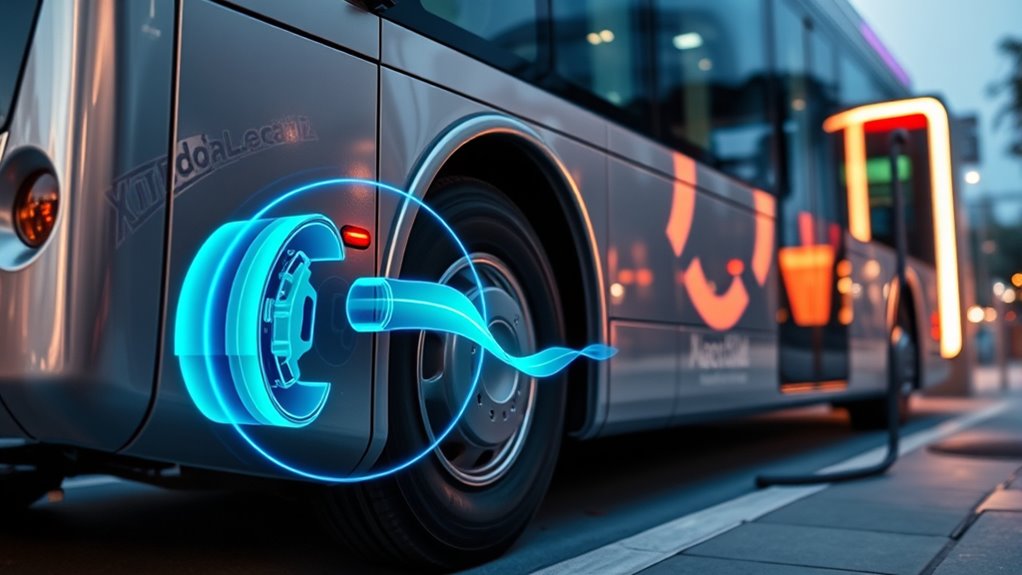
Mechanical and regenerative braking systems differ markedly in how they slow down a vehicle and manage energy. Mechanical brakes use components like pads, rotors, and drums to create friction, converting kinetic energy into heat and causing energy loss. This process wears out parts faster, increasing maintenance costs. Additionally, the color accuracy of the braking system can influence how well drivers perceive braking performance under different lighting conditions. Proper vehicle maintenance is essential to ensure both systems perform reliably and safely over time. A well-maintained system can also help in optimizing braking efficiency and safety. Incorporating local knowledge of laws can further improve the effectiveness of energy recovery strategies. Regenerative braking captures kinetic energy and converts it into electrical energy using electric motors, storing it in batteries. This reduces wear on mechanical components and extends their lifespan. Incorporating energy recovery systems can significantly enhance overall vehicle efficiency. Regenerative systems combine both methods for efficient energy recovery and safety. They also improve operational efficiency by recapturing up to 70% of kinetic energy, lowering energy consumption.
Energy Storage and Management in Electric Buses
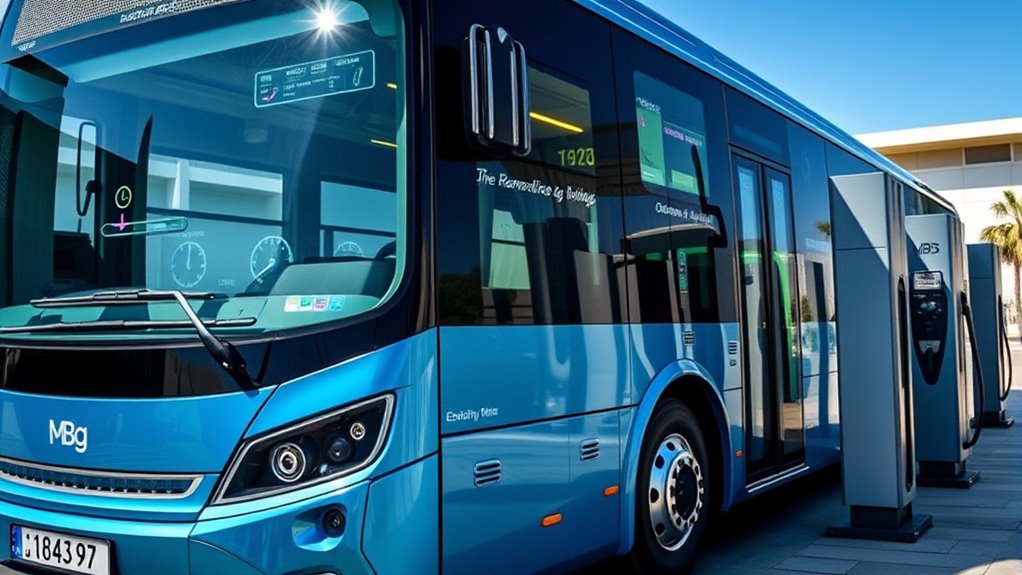
Effective energy storage and management are crucial for maximizing the performance and efficiency of electric buses. Modular battery systems offer flexibility, with configurations like Gillig’s 490, 588, or 686kWh, tailored to different routes. Understanding size restrictions for tiny houses can help optimize space for battery placement and other components. High-efficiency storage maximizes range and reduces downtime, evidenced by Gillig’s 79% decrease compared to competitors. Flexible charging options, including depot and fast on-route chargers, ensure ideal operation under various conditions. Thermal management systems prevent overheating and preserve battery health. Capacity degradation typically leaves batteries around 70% capacity at end-of-life, suitable for secondary uses. Energy management systems utilize data analytics and real-time monitoring to enhance battery performance and charging schedules. Proper end-of-life handling, including recycling and second-life applications, minimizes waste and supports sustainability, key components of sound design guaranteeing your electric bus operates efficiently over its lifespan.
Benefits of Regenerative Braking for Vehicle Efficiency and Maintenance
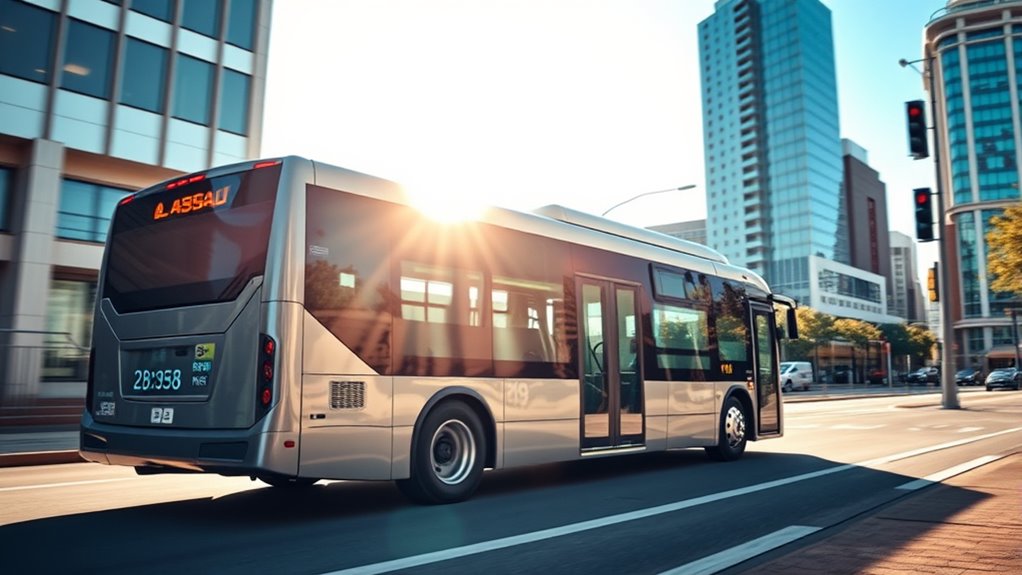
By capturing up to 70% of the kinetic energy during braking, regenerative systems markedly boost a vehicle’s efficiency. You’ll recapture deceleration energy and convert it into electricity stored in the battery, reducing waste and extending your bus’s range by up to 20%.
This process also cuts brake wear, lowering the need for frequent replacement of pads and rotors, which means less downtime and maintenance costs. Additionally, energy recapture decreases overall electricity consumption, saving on operational expenses.
You’ll notice smoother stops and improved driving dynamics, reducing driver fatigue and enhancing safety. Regenerative braking easily integrates into existing electric bus systems without major infrastructure changes, making it a cost-effective solution for fleet managers.
Environmental Advantages of Using Regenerative Technology
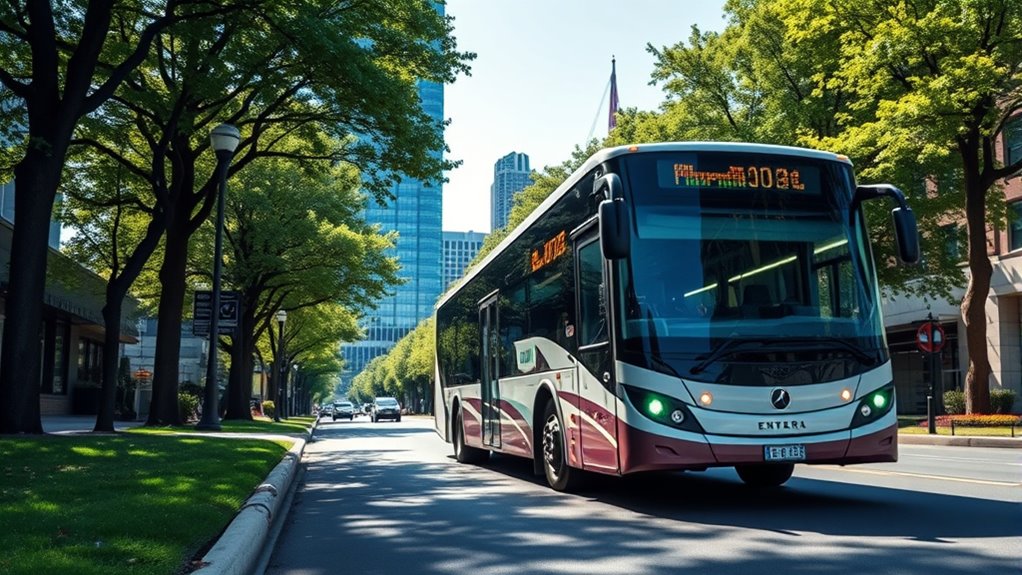
Regenerative technology in electric buses offers significant environmental benefits that extend beyond just energy savings. By capturing and reusing braking energy, these buses produce zero tailpipe emissions, helping improve urban air quality and reduce respiratory health issues. This cleaner air also benefits local ecosystems and helps cities comply with stricter pollution regulations. Noise pollution drops too, as electric buses operate more quietly, creating a more pleasant urban environment. Additionally, regenerative braking enhances energy efficiency, lowering overall energy consumption and reducing the carbon footprint. It supports the shift toward sustainable mobility by decreasing reliance on fossil fuels and promoting renewable energy use. Furthermore, this technology reduces wear on mechanical parts, leading to less maintenance and resource waste, promoting a more sustainable transportation system. Jeep Tuning techniques, for example, focus on optimizing vehicle performance while also considering environmental impacts. Incorporating sustainable materials into bus manufacturing can further amplify these environmental advantages, making the entire system more eco-friendly. Embracing electric vehicle technology‘s advancements can also drive innovation in public transportation infrastructure, encouraging broader adoption of green mobility solutions.
Challenges and Limitations of Regenerative Braking Systems
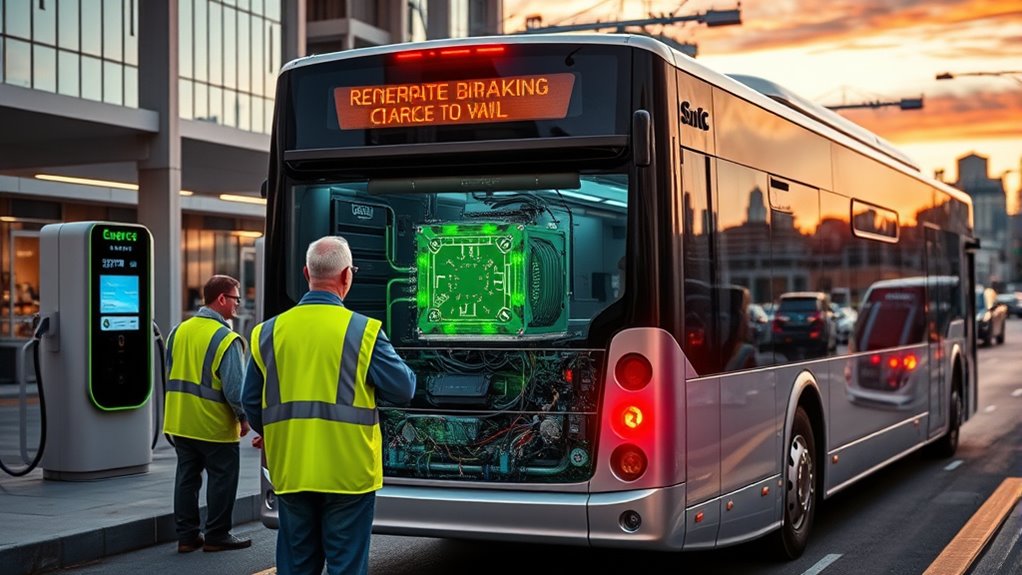
Despite its advantages, regenerative braking systems face several challenges that can limit their performance and reliability. Vehicle dynamics, like weight transfer during sharp turns or uneven terrain, can reduce energy recovery efficiency. Kia Tuning modifications to suspension and handling can influence how effectively the system performs during different driving conditions. Older buses may have diminished performance due to battery degradation, while temperature fluctuations affect battery and system efficiency. High rolling resistance tires also decrease effectiveness. Technical limitations include the maximum power output of motors, which can’t always handle high-speed braking, and electrical losses that reduce energy capture. Energy recovery at low speeds often yields minimal energy recovery. Operational issues arise from inconsistent driver habits, traffic conditions, and limited energy storage capacity, which can restrict benefits. Maintenance problems, such as battery wear, corrosion, and seizing components, further challenge system durability. Additionally, battery performance declines over time, impacting overall efficiency. Environmental factors like humidity and temperature variations can influence electrical components and reduce regenerative efficiency. Moreover, the integration of regenerative braking with traditional systems can sometimes cause braking inconsistency, affecting overall safety.
Best Practices for Optimizing Regenerative Braking Performance
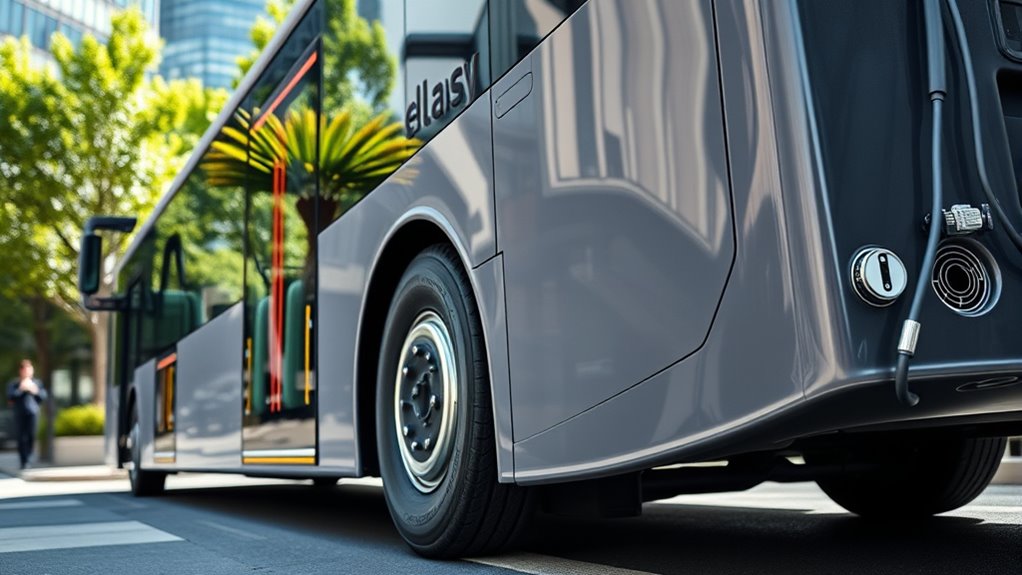
Optimizing regenerative braking performance requires a combination of strategic force distribution, advanced system integration, and adaptive control methods. You should allocate braking force between front and rear axles based on I-curve data, ECE regulations, and force distribution models to balance stability and energy recovery. Understanding vehicle dynamics helps in designing effective force distribution strategies. Dynamic torque adjustment between regenerative and mechanical braking ensures pedal consistency while maximizing energy capture. During deceleration, real-time force redistribution prioritizes regenerative torque as speed drops, improving efficiency. In addition, implementing ethical hacking techniques can help identify and address potential vulnerabilities within the vehicle’s control systems to enhance overall cybersecurity. Incorporating vehicle dynamics models to adapt force distribution for different loads and road conditions is crucial for maintaining system efficiency and safety. Utilizing advanced sensor networks enables real-time monitoring of system parameters, thereby improving adaptive control accuracy. Use high-fidelity models and sensor networks to monitor parameters in real-time, enabling precise control. Applying numerical optimization algorithms refines performance, helping you achieve better energy recovery and maintaining safety, comfort, and system longevity.
Frequently Asked Questions
How Does Regenerative Braking Affect Tire Wear in Electric Buses?
You might notice that regenerative braking can increase tire wear in electric buses. When you use this system, the electric motor engages frequently, causing constant acceleration and deceleration.
This continuous activity stresses the tires, especially during one-pedal driving modes. Additionally, the added weight of batteries and instant torque delivery can lead to uneven and faster tire wear, making regular tire maintenance more important for electric buses.
Can Regenerative Braking Systems Operate Effectively in All Weather Conditions?
You might wonder if regenerative braking works in all weather conditions. In cold, icy, or snowy settings, its effectiveness drops because reduced traction and wheel slip limit energy recovery.
However, with advanced weather-adaptive algorithms, machine learning, and route planning, you can optimize regenerative braking to perform better across varying conditions. While it may not be perfect everywhere, these technologies help maintain safety and efficiency, even in challenging weather.
What Training Is Needed for Technicians to Service Regenerative Systems?
You need specialized training to service regenerative systems effectively. Focus on gaining knowledge of high voltage safety protocols, electrical system components like inverters and converters, and diagnostic tools.
Hands-on workshops and OEM courses help build practical skills. Make certain you’re certified to work safely with high voltage systems, understand troubleshooting techniques, and stay updated on industry standards like NFPA 70e.
This training ensures you can maintain and repair regenerative braking safely and efficiently.
How Does Regenerative Braking Influence Battery Lifespan Over Time?
Think of regenerative braking as a gentle gardener tending your battery’s health. It captures energy during slowing down, boosting range and reducing wear on traditional brakes.
However, frequent cycles can gradually wear the battery, potentially leading to capacity loss over time. You can extend battery life by driving smoothly and avoiding excessive regenerative cycles, ensuring your bus remains efficient and reliable for years to come.
Are There Safety Risks Associated With Regenerative Braking During Emergencies?
You ask if regenerative braking poses safety risks during emergencies. While generally safe, the system involves complex electrical components that could present hazards if not properly managed, especially in fires or crashes.
Emergency responders need specialized training and protective gear to handle potential electrical shocks or thermal runaway. Proper maintenance, thorough safety protocols, and updated emergency response plans help mitigate these risks, ensuring safer handling during critical situations.
Conclusion
By embracing regenerative braking, you can boost your electric bus’s efficiency and reduce maintenance costs. Imagine saving up to 30% of energy that would otherwise be lost—like capturing sunlight for later use. This technology not only cuts emissions but also extends vehicle lifespan. As more buses adopt regenerative systems, you’ll help create cleaner cities and a healthier planet. It’s a small change with a powerful impact on our shared future.
